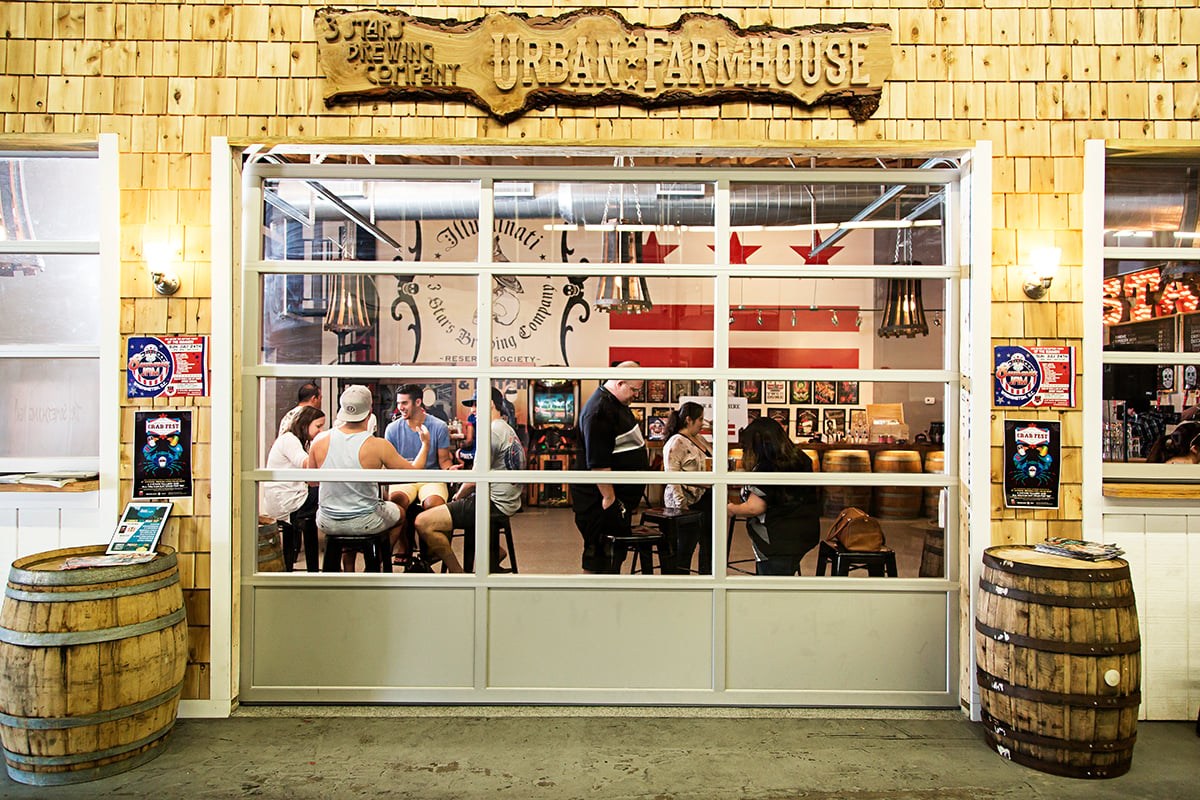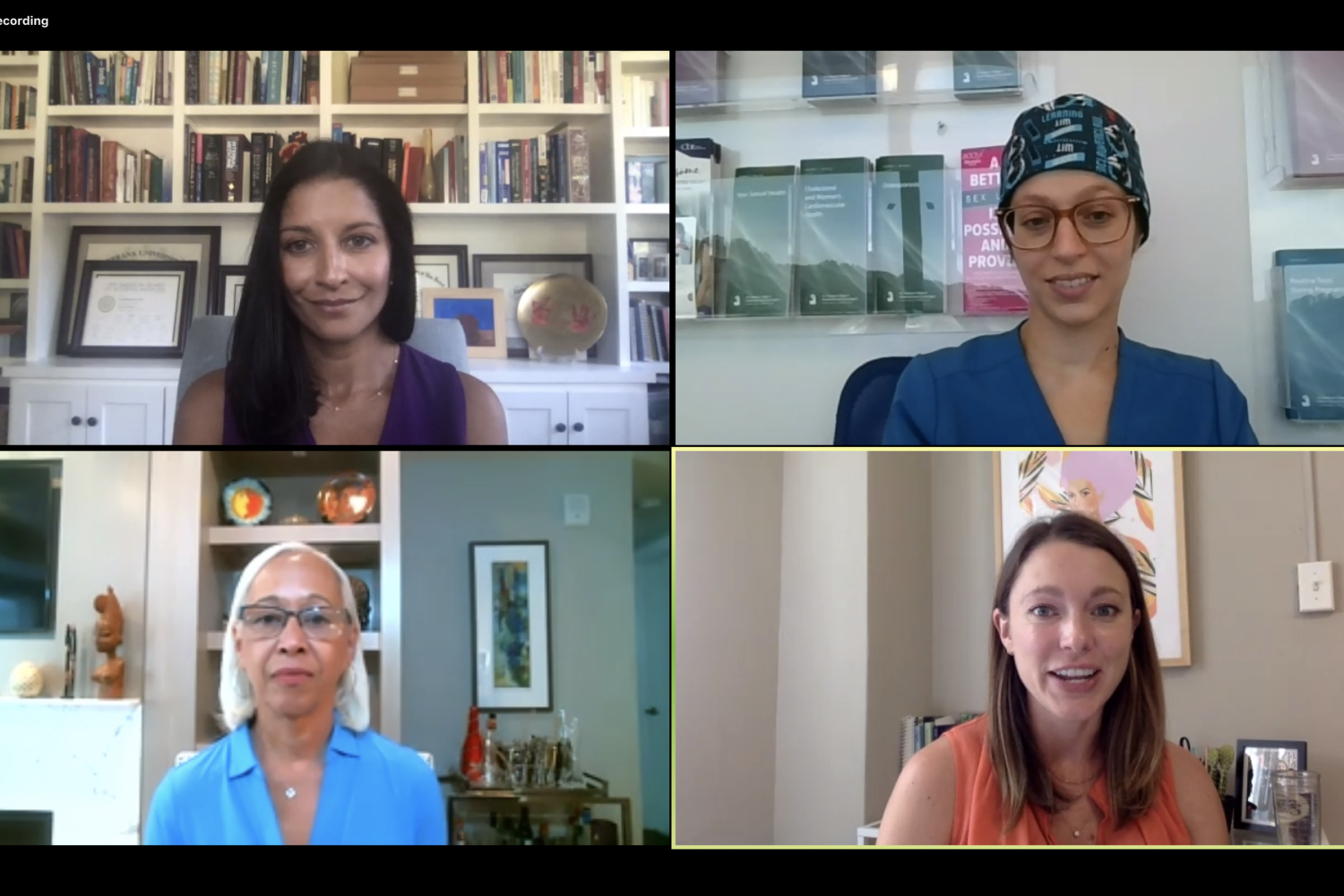There aren’t many places that bring together Darth Vader, a dead president, a moon rock, and a 12-ton bell.
Washington National Cathedral—officially the Cathedral Church of Saint Peter and Saint Paul—has them all, as well as a 53-bell carillon, nine chapels, hundreds of stained-glass windows, thousands of works of needlepoint, the area’s largest pipe organ, and stone carvings too numerous to count.
And that doesn’t begin to catalog the wonders of the place. Constructed of Indiana limestone in the style of English Gothic cathedrals—in the shape of a cross, with ribbed vaults, pointed arches, and flying buttresses—it was completed in 83 years, the blink of an eye compared with the centuries it took to build the great cathedrals of Europe. More than 500 feet long from west to east and rising to a height of 301 feet, it’s the world’s sixth-largest cathedral.
The cathedral close, the 51 acres on which the cathedral sits, was designed by the landscape architect Frederick Law Olmsted Jr. It’s now also the site of an elementary school, a boys’ school, a girls’ school, a parish church, a conference center, a library, and the offices of the Episcopal Diocese of Washington.
This month marks the 100th anniversary of the laying of the cathedral’s foundation stone. Although the building was completed with the placement of the final finial atop the southwest tower in 1990—“the last jewel in the Lord’s crown,” as mason Billy Cleland put it—work of all kinds continues both inside and outside the cathedral as it enters its second century.
The cathedral continues to define its place in the world—how to both be a building and build a community, how to cater to tourists and to pilgrims, how to be a religious institution and still serve a secular nation. All sorts of questions, delights, and curiosities reveal themselves on a walk through the place.
The idea of a national church goes back to Pierre Charles L’Enfant’s 1791 plan for the federal city, in which he suggested the construction of “a church for national purposes, such as public prayer, thanksgiving, funeral orations; and be assigned to the special use of no particular denomination or sect; but be equally open to all.” He placed the church in the area of DC that is now Gallery Place. But no church was built as part of L’Enfant’s plan.
A century later, in 1893, largely as a result of efforts by civic leaders such as Riggs Bank president Charles Glover, Congress granted a charter to the Protestant Episcopal Cathedral Foundation to establish a cathedral “for the promotion of religion and education and charity.” President Benjamin Harrison signed the charter into law.
The project got rolling under the first Episcopal bishop of Washington, Henry Yates Satterlee. After rejecting several sites, one near Dupont Circle, Satterlee jumped at the chance to buy 30 acres on Mount St. Alban, where a small parish church already existed.
Despite the word “national” in its name and its designation as the National House of Prayer, the cathedral receives no money from the government. It is also the official seat of the Presiding Bishop of the Episcopal Church in the United States, currently the Most Reverend Katharine Jefferts Schori, and of the Bishop of the Episcopal Diocese of Washington, currently the Right Reverend John Bryson Chane, but it doesn’t receive funding from the church, either.
The cathedral was built with private funds, and its operation today is funded by donations, gifts, and revenue from its shops and other endeavors.
The first activity on the new land was the raising of a Peace Cross to mark the end of the Spanish-American War. The cross stands south-southwest of the cathedral, across from St. Alban’s parish church.
In 1900, even before ground had been broken for the cathedral, Bishop Satterlee and Phoebe Apperson Hearst—wife of US Senator George Hearst of California and mother of publisher William Randolph Hearst—founded the National Cathedral School for Girls on the property. St. Albans School was founded nine years later to educate boy choristers at the cathedral.
The building of the cathedral began on the east side of the site with the laying of the foundation stone on September 29, 1907. The stone is a composite of two stones: A small stone quarried from a field beside the Church of the Holy Nativity in Bethlehem was inserted into a larger piece of American granite. At the official ceremony, President Theodore Roosevelt gave a speech blessing the future work of the cathedral. In the construction that followed, the foundation stone was covered over, symbolizing the foundation of the Christian faith on unseen mysteries.
Bethlehem Chapel, the first part of the cathedral, was built on top of the foundation stone at what is now the crypt level. A worship service has been held there every day since it was finished in 1912. The chapel was dedicated to Bishop Satterlee, who died in 1908. An alabaster sarcophagus containing his body can be seen behind the altar.
Also on the crypt level are three other chapels and a meditation center for visitors. The Good Shepherd Chapel, a tiny space accessible through an entrance off the courtyard, is open from 6 in the morning till 10 at night. A wrought-iron door by the artist Albert Paley separates the Good Shepherd area from the rest of the cathedral.
In the Chapel of St. Joseph of Arimathea, a mural depicts Jesus’s burial scene, including St. Joseph, who, according to the crucifixion story, donated for Jesus a tomb he had bought for his own body. The floor is slightly lower than the rest of the crypt level, symbolizing the low point of Jesus’s life.
Across the corridor is Resurrection Chapel. Joyful mosaics adorn the walls and the dome of the chapel’s apse. The mosaics in the back were designed by one of the most prolific and long-lived cathedral artists, Rowan LeCompte, and his wife, Irene.
LeCompte became enchanted by the stained glass on a visit to the cathedral at age 13 and took up the craft. He later met the cathedral’s main architect, Philip Frohman, at a project Frohman was working on in Baltimore. Frohman told him he wanted to install stained glass of great clarity and richness at the cathedral so that bright beams of colored light would shine on the inside. LeCompte longed to create a window for the cathedral—it had struck him on his visit as “a magic place”—and was thrilled when Frohman agreed to look at a panel of stained glass he had done for Goucher College.
LeCompte created a window design and brought it to the cathedral for Frohman to show to the building committee. Just before the meeting, Frohman asked LeCompte how old he was. Sixteen, LeCompte admitted. His design was approved and installed in a crypt chapel, starting a career of art-making for the cathedral.
Since then LeCompte has designed more than 40 stained-glass windows for the cathedral, including the great West Rose Window and all of the clerestory, or top-level, windows in the nave. At age 81, he is working on his last cathedral project, revising a window he created 26 years ago to make it brighter.
One of the best-known stained-glass windows—not by LeCompte—is the Scientists and Technicians Window, also known as the Space Window, located on the south side of the nave. A piece of moon rock brought back to Earth by Neil Armstrong and Buzz Aldrin on Apollo 11 is embedded in the window in a clear glass bubble to keep it from oxidizing.
Look up to the ceiling and around the nave on a sunny day and you can see the fruits of Frohman’s stained-glass principles. Each window throws a splash of colored light on the ceiling and walls like a collection of Easter eggs.
As cathedral literature points out, the iconography of the building—the thousands of works in stone, stained glass, wrought iron, wood, and fabric—tells the story of humankind from west to east: from creation—as seen in the West Rose Window, entitled “Creation,” and the three tympana designed by sculptor Frederick Hart depicting the creation of day, of humankind, and of night above the west portals—to redemption through Jesus Christ, the central figure in the carved-stone wall behind the high altar at the east end.
Some of the most engaging works of art—and some of the hardest to see—are those of the stone carvers who worked for dec ades creating and decorating the structure, part of a legendary community of artisans and workers who dedicated their lives and careers to the cathedral. As master carver Vincent Palumbo put it, surveying the cathedral after three dec ades of work on it, “This is my world.”
Much of their work is best viewed with binoculars. High up on the ceilings, at the tops of vaults where the ribs meet, are giant carved stones called bosses. Each of the more than 600 in the cathedral is different, and they show all sorts of things: Bible scenes, an abacus, even an abstract representation of the horrors of modern warfare, including a mushroom cloud.
Stones are still being carved. Some were left uncarved during construction to allow future generations to make carvings to represent their times. In the narthex, the entrance area on the west side of the cathedral, an area called the Human Rights Bay is about to acquire two new statues, of Rosa Parks and Mother Teresa.
The stone carving on the outside is equally intricate. In the medieval tradition, many of the structures that keep water away from the limestone building are carved in the forms of fantastic creatures. Called grotesques, the carvings range from hideous to humorous. The grotesque of Darth Vader, located nearly at the top-center of the northwest tower, is the result of a children’s design competition.
Some carvings are representations of the carvers themselves. On the north exterior wall, a gargoyle—a grotesque that spouts water out of its mouth—depicts master carver Roger Morigi as a devil, complete with cloven hoof and pointed tail, carrying carving tools, a pistol, a dagger, a flask, and a set of golf clubs. A grotesque on the southwest tower shows carver Vincent Palumbo with curly hair, a bushy mustache, and a cap topped with a flagpole, commemorating the time he bent the cathedral’s flagpole in an accident with his pickup truck.
On a flying buttress on the north side of the nave is a memorial to stone carver Joseph Ratti, who died from a fall when scaffolding gave way. The stones he was to work on have been left uncarved. There’s also a representation of him carving an unfinished gargoyle on a balcony in the south transept.
Legend has it that a stone carver’s wife died and the carver wanted her buried in the cathedral. The cathedral said no. Late at night, the carver crept into a work area and mixed his wife’s ashes with mortar, so she was interred in the cathedral after all.
Above the crossing of the cathedral where the transepts—the “arms” of the cross—meet, the central tower rises 301 feet above ground and 676 feet above sea level, the highest point in Washington. The tower was built in the 1950s and ’60s, just after the east end and transepts but before the long west end, or nave; the dean thought the inspiring sight of the tower would open more wallets.
Above the crossing, staff and visitors on special tours can gain access to the areas atop the apse and the transepts. There, between the ceiling and the roof of the cathedral, it’s possible to step off the wooden planking and walk on the stones that top the 102½-foot space beneath. People come out here to raise and lower the chandeliers, coordinating with people below through walkie-talkies, or to check very sensitive devices that measure the settling of the cathedral.
On a special tour you can walk outside onto the narrow walkways overlooking the flying buttresses; there you’ll see dec ades-old graffiti by boys at St. Albans School from the days when keys to nonpublic areas of the cathedral were easier to steal.
Above this first level in the central tower is the carillon, a musical instrument in which bells are rung by pounding a keyboard with one’s fists. Each key connects with a system of levers and pulleys that activates a clapper, which swings and hits a bell. Each of the carillon’s 53 bells is inscribed with a Bible verse. The largest bell, called the bourdon, is 8½ feet wide and weighs 12 tons. Bearing the inscription the lord he is god, it’s rung alone on mournful occasions.
The room housing the carillon has tall openings in the walls to let the sound of the bells reverberate into the neighborhood. The room affords views for miles in any direction, but the carillonneur is usually the only person who sees them from this vantage. Visitors are afforded similarly impressive views from the Pilgrim Observation Gallery in the west end.
Above the carillon is the ringing room for the ten peal bells. In the center is a raised circular platform with ten ropes ending in loops dangling above it. The ropes are connected to bells on the floor above that range in size from 600 pounds to more than 3,500.
When peal bells are played, the whole bell rotates from mouth upward to mouth downward, instead of staying stationary like the carillon bells. After the bell is played, a mechanism returns the bell to the mouth-up position to be played again.
Because the mechanism takes time to reset, notes can’t be repeated in close succession, so peal bells are played in mathematical patterns rather than tunes. A specific number of bells is selected, and with one ringer per bell, each is played in a predetermined sequence. Then, according to the method selected—many of which have odd names—a new sequence, generated from the previous sequence, is played. Each sequence is called a change.
Example: If ringers decide to play six bells in the method called Plain Bob Minor, the first sequence is 123456 and the second is 214365, swapping each of three adjacent pairs. The next change is 241635, leaving the end bells the same and swapping two internal pairs. The ringers go on until someone makes an error or quits. If they play all the possible arrangements, which would be 5,040 changes with seven bells, that’s a full peal. Not many more than 100 full peals have been rung on the cathedral bells in the 43 years since the first one. Anyone can become a ringer (with practice) through the Washington Ringing Society.
The most familiar—and impressive—instrument at the cathedral is the Great Organ. A 1938 Ernest M. Skinner instrument, the organ originally had 8,015 pipes and reached its current size of 10,250 pipes when its second revision was completed in 1975. It’s the largest single pipe organ in the Washington area. The organ console, where the organist sits to play, is on the south side of the Great Choir, just east of the central crossing.
A major project to design and build two new organs for the cathedral is under way. Because the nave of the cathedral didn’t exist when Skinner installed the organ in 1938, the sound doesn’t travel well to the farther seats, creating problems with congregational singing. A new organ in the choir will be connected to another new organ in the west gallery, allowing the sound to fill the nave.
The Great Organ is a marvel to behold and to hear—which doesn’t have to happen only during services. Organ recitals are often held on Sunday afternoons, and on most Mondays and Wednesdays an organ demonstration and mini-recital are given from 12:30 to 1.
Music is a major part of the life of the cathedral. Two accomplished choirs—one featuring men with boys from St. Albans School, the other men with girls from the National Cathedral School—provide music at many services. The cathedral also serves as performance space for the Cathedral Choral Society, a 240-voice chorus that performs oratorios and other large works under the direction of J. Reilly Lewis. A summer music festival brings top names in choral and chamber music, organ, jazz, blues, and Broadway; admission is free for many performances.
The West Rose Window, “Creation,” designed by Rowan LeCompte, was installed in 1976, the year the nave was completed, in time for US bicentennial celebrations. The window is an abstract representation of the creation story. Many of the more than 10,000 individual pieces of glass are faceted to reflect light differently at different times of the day—the dominant color changes from blue to pink as the day latens.
If you stand under the rose window and face east, toward the high altar, you might notice that a line straight down the center aisle doesn’t point directly to the center of the altar. You have to make a slight left at the entrance to the Great Choir area to stay in the center of the church. The reason for this is debated. Among the notions put forward are that the asymmetry reflects the tilt of Jesus’s head or his broken body on the cross, that it is intended to remind worshippers that only God is perfect, or that is the result of a drafting error.
In the first bay on the north side of the entrance, a statue of Abraham Lincoln and the text of his farewell address to the citizens of Springfield, Illinois, as he left for the White House pay tribute to the slain president. Lincoln-head pennies are embedded in the floor. Opposite Lincoln on the south side is a statue of George Washington. Flags of all 50 states line the walls of the nave.
The third president represented in the nave is Woodrow Wilson, whose body is interred in a stone casket about halfway down the south side. Flags of the United States and of Princeton University, where Wilson also served as president, are tucked into the corners of the bay. Wilson is the only US president buried in the District of Columbia.
Helen Keller is also buried in the cathedral, along with her teacher, Anne Sullivan. Admiral George Dewey, a longtime trustee of the cathedral, is buried there, as is cathedral architect Philip Frohman, who was killed when he was hit by a car on the cathedral grounds in 1972.
Also killed on the cathedral grounds was Catherine Cooper Reardon, an assistant librarian murdered in the library building in 1944. Her murderer, a handyman and janitor named Julius Fisher, choked her and clubbed her with a fireplace log, then stuffed her body under steam pipes in the basement. Newspaper accounts of his initial confession say Fisher attacked Reardon after she criticized the job he had done sweeping under her desk. He was sentenced to death by electrocution. In appeals that reached the Supreme Court, Fisher claimed Reardon had used a racial epithet that sent him into a rage, so the crime was not premeditated and therefore not deserving of capital punishment. Fisher lost his appeals and was executed.
As lively as the lore of the cathedral is, life on the close revolves around worship, education, and ministry. Describing itself as “an Episcopal church for people of all faiths and beliefs,” the cathedral hosts five Eucharistic, or Holy Communion, services most weekdays—six daily in the summer—and six most Sundays. Prayers for peace are said every hour the cathedral is open. A choral evensong—a service of readings, prayers, and choral music—is held at 5:30 pm most weekdays and at 4 on Sundays.
In addition to being a house of worship, the cathedral is, as Dean of the Cathedral Samuel T. Lloyd III puts it, “a sacred place to celebrate events that have shaped our country, to mourn in times of loss, and to address the pressing moral and social issues of the day.”
It’s the site of memorial services for presidents and other prominent figures, most recently Ronald Reagan and Gerald Ford. It hosted interfaith services after September 11, 2001, after Hurricane Katrina, and for the hostages in Iran in 1980.
The cathedral has been at the forefront of social-justice issues for many years. Martin Luther King delivered his last Sunday sermon from the cathedral pulpit in 1968.
The Cathedral College, headquartered in a separate building northeast of the cathedral, conducts conferences and educational programs for clergy and laity from all denominations and faith traditions; it also runs interfaith initiatives devoted to social justice and reconciliation and alleviating poverty and disease. Current initiatives include efforts to eradicate malaria in Mozambique, promote gender equality worldwide, and stop human trafficking.
Closer to home, the cathedral’s efforts to increase connections with DC communities east of Rock Creek Park include a program called Cathedral Scholars in which promising students from District public schools undergo three years of academic enrichment, college preparation, and internships. Worship services often feature African-American choirs and music.
These programs are foundational parts of the “generous-spirited Christianity” articulated in “A New Century, a New Calling,” a document produced by a committee charged with discerning the cathedral’s direction after completion of the construction precipitated a “what now?” moment. Central to this ministry is building a faith—and interfaith—community that is at once local, national, and global. Dean Lloyd says this means a commitment to ideals of compassion, respect, intellectual openness, hospitality, and tolerance—including tolerance of those whose views some at the cathedral might view as intolerant. Leaders of the cathedral say they strive to welcome all points of view, even those they disagree with.
The cathedral long ago welcomed gay men and lesbians not only into the life of the church but also into the clergy and church hierarchy, a position that puts it, along with the Episcopal Church of the United States, at odds with more conservative members of the worldwide Anglican Communion. Some churches, including several in Virginia, have broken with the Episcopal Church and allied themselves with a Nigerian bishop who is a leading opponent of the participation of gay people in the church.
A major change is the decision to build a congregation of the cathedral’s own. There have always been regular worshippers, but until recently there was no mechanism for becoming a member of the cathedral congregation and little focus on such traditional parish concerns as pastoral care. Leaders anticipate that many new congregants might be newcomers to the city—perhaps even to Christianity—and hope a regular congregation will create greater intimacy at the church and erase perceptions of it as an elitist institution.
The cathedral welcomes 700,000 to 800,000 visitors each year, many of them tourists who come not entirely for a religious experience but also to see the gargoyles and the moon rock. They often wander up and down the aisles while services are being held.
Most eventually make their way to the Museum Store on the crypt level, which sells cathedral-themed T-shirts and ties, antiquities, games, miniature gargoyles, CDs of cathedral choirs, books, and at least six versions of the Bible. One of the most popular items is an umbrella bearing the likeness of LeCompte’s “Creation” rose window. Gifts for the home can be bought at the Herb Cottage just outside the west entrance. The Greenhouse just down the close sells flowers, plants, and garden accessories—including live ladybugs, praying mantises, and earthworms.
Opportunities to take part in the religious life of the cathedral are posted for visitors, but no one is pressured. Dean Lloyd says visitors who ask are told about the cathedral’s message of welcome and reconciliation without making it feel like a Sunday-school lesson. Tours focus on the beauty of the building rather than on theology or worship.
There’s much more than can be covered in a single visit. The more you go, the more you discover. Explore the place for yourself and you might find something you didn’t know you were looking for.

















